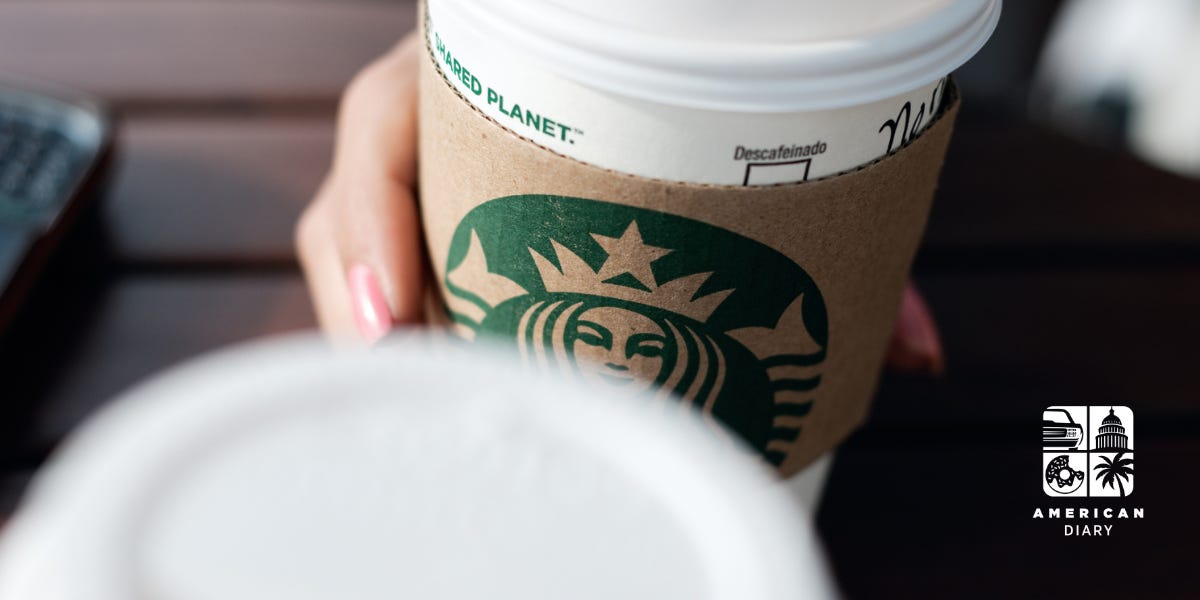
Three Cheers for the Third Place
Starbucks’ recent refocus on the in-person experience reminds us that we still need communal places

I’m old enough to remember when Starbucks sold CDs. I also remember the thick, colored glass light fixtures that dimmed the light, the big furniture that made the stores feel bigger than they were, like you could hide from everybody for a little while. I’m old enough that when I walk into a loud, square, unadorned Starbucks today and I feel like a lab mouse under harsh fluorescent lights, I notice it.
My wife and I pass a Starbucks driving to our usual supermarket, and we always glance over at the drive-thru line to see how many cars are waiting. It’s often quite a few, even at odd hours. Is it really that hard to brew your own (kind of thin) drip coffee? Do you really need a milkshake containing maybe 15% of that coffee by volume?
But maybe “skip it” or “make it at home” is the wrong choice. What about the question we didn’t used to have to ask about coffee shops: How hard is it to go in and sit awhile?
Well, harder than it used to be. Yes, we love our convenience, our app ordering, our frictionless experience that conceals human effort, diminishes human contact and appears to transmogrify a few taps on a screen into a physical artifact. But sometimes a little friction is good, and sometimes you want to slow the pace. But that costs a business money—in interior design, in furniture and fixtures, and in customer turnover—and when the online orders and the cars never stop coming, why spend it?
The Pendulum Is Swinging Back
Like many businesses, Starbucks made a shift toward drive-thru and app-based ordering during the pandemic, which, to be fair, was about the only way restaurants could survive. A 2020 article in Fast Company reported on the growth in the drive-thru business: “Whereas about one-third of Starbucks locations in the U.S. have drive-through today, 60% of the locations in the pipeline will have drive-throughs. Plus you’ll see more drive-throughs installed in older buildings through retrofitting.”
And beyond that, a Starbucks executive even telegraphed to Fast Company that the famous “third place” identity of Starbucks was going by the wayside:
“We’re learning that our customers really feel that experience isn’t just sitting in the store. It’s when you hand off that beverage, and the interaction between the barista [and customer] ... that can happen at the drive-through, or the entryway pickup. We feel like we’re creating a third place, just in a different venue.” It’s an idea that Starbucks has been validating, too—studying “customer connection scores,” or researching how customers feel about the Starbucks brand now that it’s more convenient than experiential.
Oh, so the customers want to be hassled out the door!
Maybe we did. But something didn’t quite work out, because Starbucks’ sales have not looked great for some time, and the chain is reversing course and suggesting that the third-place identity was too watered down for awhile. This is quite a different tune from five years ago:
To reinvigorate the third place experience, Starbucks is testing a new store model that considers expanded seating options catering to work, socialization, and relaxation; more power outlets to encourage longer stays for remote workers, students, and professionals; and an improved ambiance to make stores feel more inviting and community-oriented. The new layout includes dedicated areas for mobile pickup and new risers and pickup shelves to allow for better organization and distinction between in-store guests and mobile customers. Additionally, the brand is piloting abundant food displays to showcase offerings and encourage guests to try new items and a redesigned espresso bar to add a sense of theater to the coffee ordering experience.
There’s something interesting here: The pandemic first necessitated a move away from in-store lingering, saw an explosion in quick app-based transactions and brought new life into the drive-thru business. But the rise of more permanent remote work means that more people need somewhere to sit and work and just get some air or some low-stakes human contact that isn’t their office or their home. Which is precisely what a third place is.
The Different Parts of Us
There’s a negotiation here between different parts of us. This great blog from Jim Dalrymple II captures the tension between wanting the human contact and good friction of going out and ordering something and enjoying it around people, versus spending a lot of money to in-source, as it were, that thing into your home. His example is a reasonably affordable countertop soft-serve machine versus going out for ice cream.
Dalrymple writes:
[I]nfinite soft serve ice cream is now within my grasp. But getting a soft serve machine at my house would almost surely lead to a lonelier existence. I’d have fewer things to do for date nights with my wife, or on outings with my kids. I’d spend less time in “third places,” or those places that aren’t home or work but which provide opportunities to interact with other people. The simple flânerie of sitting with and watching strangers would be replaced with scarfing down 10,000 calories of soft serve by myself at 2 a.m.
We Americans love buying and consuming, and we also love self-reliance, or at least the idea of it. A professional-grade soft-serve machine, or an automatic espresso maker, or a car full of screens that functions as an entertainment system on wheels—all of that stuff lights up both our passive-consumption and self-reliance desires. It takes a little bit more work to refuse something like that. Some might even look askance at this whole third place business as a little too, perhaps, “European.” By which I mean a tendency in American culture to idolize hustling, climbing, being on the move—on looking at people in plazas and piazzas and cafes, doing nothing in particular, and seeing laziness or lounging instead of something deeply human. Perhaps, however, Starbucks as possibly America’s most iconic example of the third place is itself quintessentially American.
There are relatively few other businesses capitalizing on (or commercializing) this third place idea, or at least that explicitly invite you to linger. But one other chain leaning into comfortable space is Cava, the Mediterranean fast-casual chain. Sort of like Panera in the old days (Panera is another chain that has slimmed down its seating in newer restaurant designs), Cava is switching to cozier, warmer, more comfortable dining rooms in a bid to actually get people to stay longer and maybe even socialize with one another.
Ultimately, as humans, we want and need connection. The pandemic was obviously a kind of hinge point in a lot of things. At the very least, we’re still feeling its political and psychological fallout. But the idea that a couple of years of restrictions would permanently redefine human relationships and commerce and commuting and offices turned out to be facile or naive. There are certain things we want and need, and current events aren’t going to change that. Businesses rarely do things out of kindness, so we can assume these companies see profit in more welcoming, easygoing spaces, and take some heart in that.
Even in its American, commercial form—we take what we can get—three cheers for the third place.








